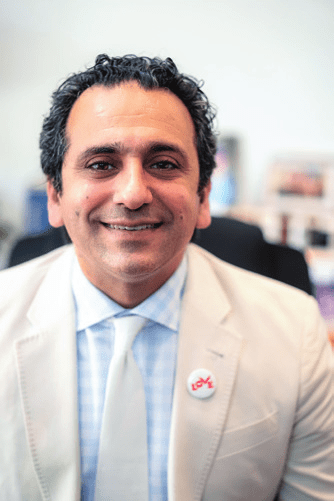In a time shaped by chaos, uncertainty and a lack of control, consciously deciding how to confront the turmoil and discomfort could be your fastest route back to contentment, says Dr. Habib Sadeghi.
The longer I live the more I realise that the quality of one’s life isn’t dependent on how many things and experiences we can acquire and hold on to, but how good we are at letting them go. When a personal crisis happens, the context we place it in has as much to do with how we experience loss as the material circumstances themselves. By realising we can choose how to define and ultimately experience a personal crisis, we gain a greater sense of control over our lives at a time when it’s easy to be lulled into inaction by feelings of powerlessness.
It’s important to appreciate that suffering through a tragedy isn’t the same as being immobilised by the pain of the experience. It doesn’t matter what the crisis is, a surprise divorce, death of a loved one, shocking diagnosis or financial devastation, we can improve our quality of life during the event by making the choice between pain and suffering. Of course, we first must be aware that we even have this choice. Once we are, we can clear out the chaotic thoughts that cloud our thinking and decision-making during a crisis and create mental space for deeper realisations about how and why the situation occurred.

Dr. Habib Sadeghi
Painful Polarity
If we think of a single dot, we know that it’s a one-dimensional entity with no depth. When we enter a crisis unconsciously, our stress response is triggered, and our thought process becomes chaotic and one-dimensional, like the dot. Everything is bad about the situation and nothing is good, as we collapse into a negative state of being. We’re the victim of someone or something else, and we don’t know why this is happening to us. It’s so unfair, and we just want it all to go away. Because our pain has no meaning outside our own victimhood, we’re not easily comforted. Here we often reach for things outside ourselves for temporary relief or distraction from our upset.
Some philosophers define a place where the soul cannot be satiated – as if we could eat the whole world and never be filled up. It’s also the place where addiction resides. I call this way of being ‘the judgmental realm’ because of the rigid way in which it defines experiences where whenever we don’t get what we want exactly how we want it, the result is great pain. We cannot consciously act from this state of mind, but only unconsciously react to our circumstances. The way out of this subconsciously inflicted pain cycle is the willingness to consider that there might be some benefit for us amid all the upheaval, even if we have no idea what it could be. Just being open to that possibility expands our consciousness from that of a dot to a flat circle that now has a visible circumference and surface area. We have two-dimensional thinking that while still polarised, can at least consider that the situation might not be all bad. It’s the beginning of peace of mind and relief. I often demonstrate this progression for my patients by scrunching a deflated balloon down into a tiny ball to represent the dot, then flattening it out like a pancake to take the shape of a circle.
Dimension and Definition
The final transition occurs when the thought process goes from being two-dimensional to a multi-dimensional state – or from the flat circle to a sphere with height, width and depth. We can think of it as finally blowing the balloon up to create a three-dimensional object with space inside to hold a deeper understanding. In this state, we have the ability to think through our feelings as we experience them in real time and not be subconsciously controlled by them. We can simultaneously be in the head and the heart as we begin to work through and make sense of our experiences. In this state of open mind, we create sufficient space where the mental noise used to be, to allow new realisations about our circumstances to arise.
This is what I refer to as ‘the state of clarity’, the ability to free oneself from the polarity of a problem and remain open to the deeper answers as to why this situation has appeared in one’s life. When we have these answers, our previously senseless pain transforms into suffering, which is loss defined by meaning. When our pain has meaning, we can suffer it with courage and peace of mind because even though we may not be able to fix everything, we know why it’s happening, and that part of the reason holds something good for us. Here, we are open to all possibilities the situation may hold, which is why I define this level of consciousness as the imaginative realm, where we are capable of imagining and holding in mind other outcomes instead of just the worst-case scenario.
It’s in this state of being that people shed their victim mentality and feel increasingly empowered, even though none of the physical details of their situation has changed yet. Once they see the gift their crisis has brought them, their gratitude often leads them to want to be of service in some way regarding their crisis. An example of this might be someone using the opportunity of being diagnosed with lung disease to speak to young people about smoking addiction. Others use their experiences to greatly improve relationships or completely change their lives and start following their passions, because life is too short. Would getting laid off from your job be so bad if it turned out to be the catalyst to start the business you always wanted? In many cases, these people often end up saying that what they previously saw as a crisis turned out to be one of the best things that ever happened to them. That’s multi-dimensional thinking or clarity, where our choices are no longer based on reaction but realisation.

Finding clarity in a crisis – whether pandemic or personal – is paramount for moving forward. Model wears: Bodysuit and trousers, DAVID KOMA; jacket, ASHLEY WILLIAMS; gloves, JITROIS
Continuum of Consciousness
When I draw the simple images of a dot, circle and sphere to demonstrate this transition of awareness for my patients, I always put dual direction arrows between the images because at any time in life, we can move forward or backward along this continuum of consciousness. While we may be able to maintain clarity over the loss of a job, perhaps the loss of a marriage causes us to handle that situation quite differently and collapse into a rigid, judgemental way of interpreting the experience. Self-awareness in all areas of one’s life is essential to prevent this from happening.
My wife, Sherry, and I teach the clarity process when we consult with couples who are breaking up and want to consciously complete their marriage instead of experiencing a traditional, adversarial divorce. We share with them the tools they need to prevent anger and resentment from contracting their consciousness back into a dot. It helps them maintain higher priorities during the separation process and avoid the antagonistic and self-righteous attitudes that too often destroy health, family and finances along the way. It keeps them aware of the fact that there is something to learn and even be grateful for in the experience of completing their life together, and that it’s their job to come to those realisations for their sake and the welfare of the family. In the situations where two people can maintain clarity and think through their feelings during the difficult separation process, they often end up having a better relationship than they did during their marriage.
Reverence for Suffering
In his book, Answer to Job, Carl Jung examines the Biblical character’s life of near-constant tragedy and how he chose to respond to his challenges. Throughout this work Jung tells us that the key is to maintain a level of reverence for suffering, to respect it and not fear it, to expect it and even welcome it in when it arrives. It is in the open mind, the sphere of our expanded consciousness with depth and space that spirit comes to meet us and we receive answers that reveal us to ourselves. The search for clarity is the path to existential maturity and taking personal responsibility for everything in our lives. In return, while we may not be able to control all the situations life brings us, we receive the ability to choose how we will experience them and thus create a much greater quality of life regardless of what happens. We get to reorganise our way of being with ourselves and interacting with the world that creates a model for personal growth through self-care that’s independent of our circumstances. As a sphere, the Earth rotates on its axis and the hemisphere that’s experiencing darkness will always turn to face the sun once more. In the same way, expanding our thinking into multidimensional, spherical form ensures that the dark times of our lives will once again be bathed in the rising of the light. For more health insights from Dr. Sadeghi, please visit beingclarity.com
Photographed by: Sylwia Szyplik | Styled by: Calvin Paleye
Read Next: Here’s how active therapy can help you navigate the new normal
- Words by Dr. Habib Sadeghi





